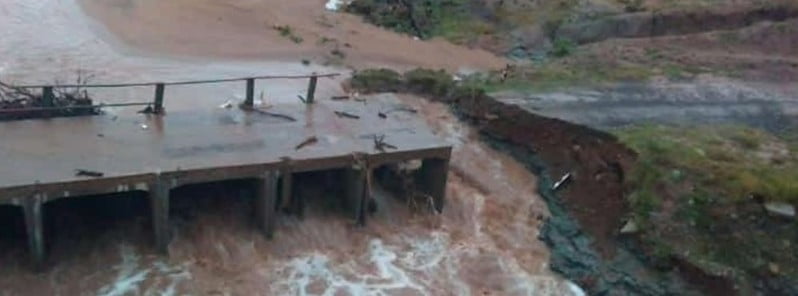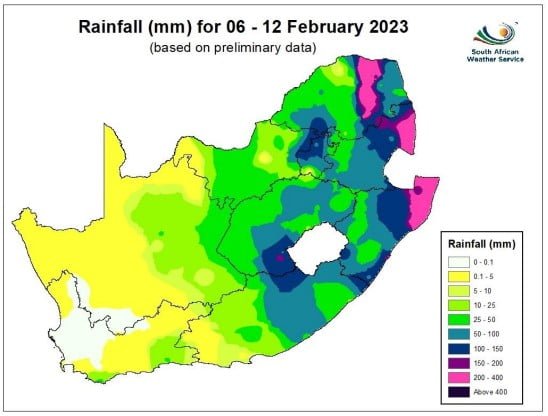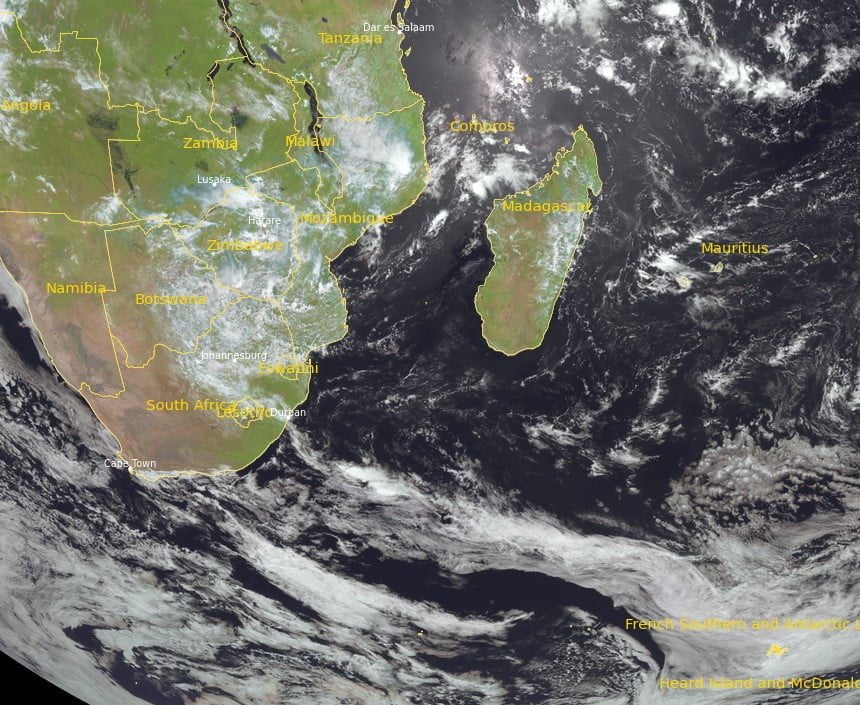National disaster declared in South Africa as extreme rains cause widespread damage

South Africa has declared a National State of Disaster due to the widespread impact of floods in several provinces, which have caused the loss of lives, severe damage to infrastructure, and affected homes and businesses. The flooding was brought by heavy rain affecting the region since February 8.
The heavy rainfall was produced by a cut-off low-pressure system that developed over the western interior on Wednesday, February 8, 2023, before moving into the central interior where it became quasi-stationary from Thursday until Saturday, February 11 before dissipating on Sunday.
The South African Weather Service (SAWS) reported that ample tropically sourced air was advected southwards from northern Namibia and Botswana, where significant rainfall had occurred lately due to the presence of a tropical low called an ‘Africane’. Cut-off lows are notorious for causing severe weather over South Africa, such as heavy rainfall and flooding.
The extreme rainfall resulted in widespread flooding, with major rivers, especially those transiting the Kruger National Park and Lowveld, being in a full flood since the beginning of the weekend. The Escarpment and Lowveld regions of the Limpopo province and particularly the Mpumalanga province have borne the brunt of the flooding, with the southern half of the Kruger National Park particularly affected. Many low-water bridges and causeways, including the Crocodile bridge and the causeway at Lower Sabie camp, are flooded, while numerous main roads, including the main road linking Skukuza to Lower Sabie, are closed due to flood damage.
Furthermore, an additional low-pressure system over southern Mozambique and northern KwaZulu-Natal (KZN) significantly elevated the risk of flooding along the KZN coastline for Saturday night, prompting the South African Weather Service to broaden the Orange Level 9 Impact-Based warnings to include a significant portion of eastern KZN.
Overnight measurements of rainfall revealed that Charters Creek in KwaZulu-Natal received 242 mm (9.5 inches) during Saturday into early Sunday morning while Tshivhasie Tea Estate in Venda in Limpopo received 294 mm (11.6 inches) on Friday into Saturday morning.
Despite the cut-off low having weakened significantly, there is a fresh rain system currently moving into Zimbabwe today from the east, expected to move westwards in the coming days.
This system is a so-called east wind wave and is likely to herald a further episode of persistent and sometimes heavy rain for the northeastern and northern provinces, which are already saturated and rain-soaked following the heavy rainfall of the past week. An easterly wave is a tropical phenomenon, where tropical easterly flows result in disturbances that bring rainfall over the northeastern regions of South Africa. These waves in the lower atmosphere are usually associated with the Inter-Tropical Convergence Zone (ITCZ).

The Government of South Africa declared a National State of Disaster on Monday, February 13, 2023, as widespread floods continue to wreak havoc in several provinces.
The floods have affected Mpumalanga, the Eastern Cape, Gauteng, KwaZulu-Natal, Limpopo, the Northern Cape, and North West, resulting in flooded homes, vehicles swept away by floodwaters, overflowing dams and sewerage facilities, loss of basic infrastructure, damage to roads, bridges, and a Limpopo hospital. The floods have also led to the loss of lives, with two fatalities recorded so far.
The worst affected are Mpumalanga and the Eastern Cape.
Heavy rains and floods have also impacted food production, with farmers experiencing crop and livestock losses. Unfortunately, further losses are expected due to the predicted continuation of heavy rains.
According to government officials, the floods were caused by the La Niña global weather phenomenon which is expected to persist during the early part of 2023, with the most significant impact on rainfall occurring during the mid-summer months.
According to SAWS, persistent and heavy downpours are expected to continue in the Lowveld and along the escarpment areas of both Limpopo and Mpumalanga. An Orange level 9 warning was issued for Monday, February 13 due to significant rainfall amounts in these areas over the last few days. Current high-resolution numerical models suggest further 24-hour rainfall accumulations of 100 to 200 mm (4 — 8 inches), especially along the escarpment of Limpopo on Monday and Tuesday, February 14.
Other areas in Limpopo and Mpumalanga will also see showery conditions, which may result in flooding because soil moisture content is high, and catchment and river systems are full. These severe impacts may occur especially over the Mopani and Vhembe Districts of Limpopo until at least Tuesday, resulting in prolonged strain on Disaster Management and emergency personnel.
The easterly wave is expected to weaken gradually starting on February 14, in the evening, resulting in the intensity of prolonged rainfall subsiding. Despite this, scattered to widespread showers and thunderstorms are still expected for the remainder of the week for a large portion of the country.

Southern Mozambique has also been hit hard by heavy rainfall since February 8, 2023, resulting in significant flooding in Maputo City and the rest of Maputo Province.
According to the World Meteorological Organization, over 400 mm (15.75 inches) of rain was recorded at the weather station in Mavalane, Maputo in just 24 hours on February 8.
The floods have resulted in seven deaths and two injuries, with over 36 770 individuals affected, including nearly 20 000 residents in Maputo City.
The material damage from the floods has been extensive, with 7 365 damaged homes, 15 health centers, and 15 schools.
In addition to material damage to buildings, 17 740 ha (43,636 acres) of agricultural land has been flooded, impacting food production in the area.
At least 270 km (168 miles) of roads and paths and impassable
References:
1 Cut-off low to bring widespread showers and flooding to central and eastern South Africa from Wednesday – SAWS – February 6, 2023
2 Heavy rain and flooding observed across eastern South Africa, with further rainfall anticipated for the northern and north-eastern provinces – SAWS – February 13, 2023
3 National State of Disaster declared on floods – Govt. South Africa – February 14, 2023
4 Seven dead, thousands affected by severe flooding in southern Mozambique – The Watchers – February 13, 2023
Featured image: Flood damage in Eastern Cape, South Africa — February 2023. Credit: Chris Hani District Municipality

Commenting rules and guidelines
We value the thoughts and opinions of our readers and welcome healthy discussions on our website. In order to maintain a respectful and positive community, we ask that all commenters follow these rules.